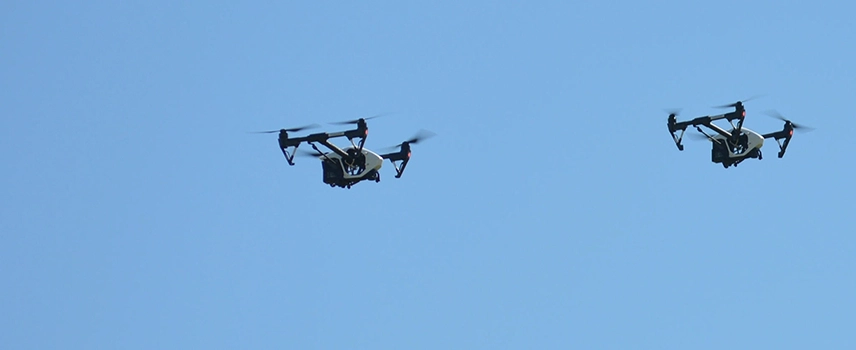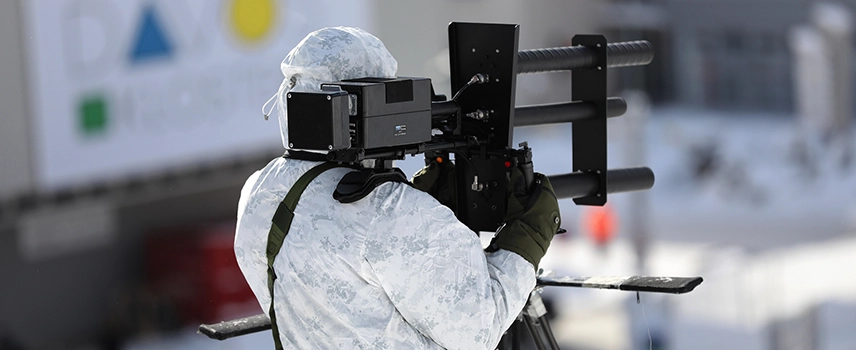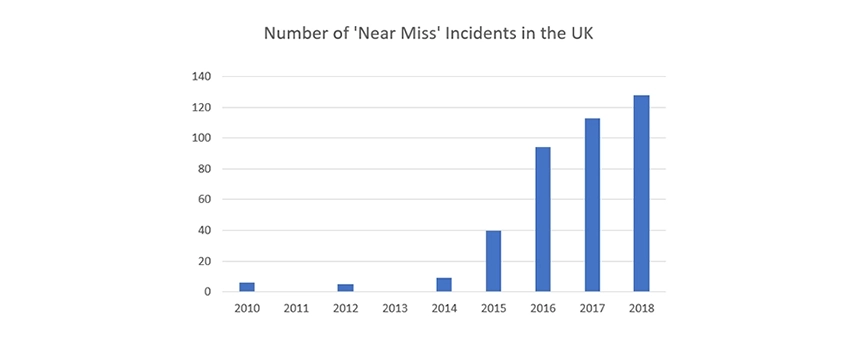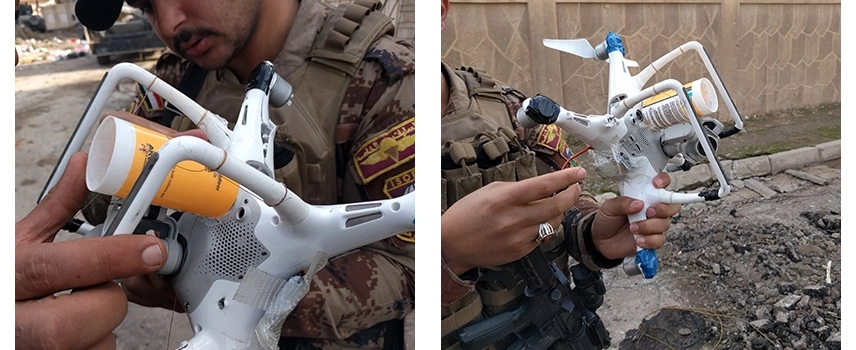Drones: useful tools, toys or weapons?
“Is society ready to deal with the possible security ramifications of drone technology?”
by Alex Bomberg | 8th Jul 2019

Are drones a security menace?
Drones have been around for a few years now and it goes without saying that the commercial drone sector is literally flourishing. But with entry level prices as low as $100, recreational drone use may well go out of control.
Some countries do have strict laws around the use of drones, including Airspace restrictions or exclusion zones around airports and national infrastructure and some have banned drones altogether.
Numerous international Security Industry professionals are deeply concerned about drones, their illegal use and the seeming lack of urgency in getting laws changed to cover their ownership and use.
Are we ready for this technology?
Drones will bring benefits, for sure. Their low price and the quality of the cameras now means that they are available to all, from professional wedding photographers through to school children and of course available to criminal elements and terrorist groups.
1984 was the year that saw the start of the modern drone industry, fueled by the military’s desire for first a surveillance platform, and then in the later years a strategic strike platform. Many military and intelligence professionals described the intelligence-gathering capability of drones, predominantly their ability to continuously observe targets for prolonged periods, as their most significant attribute.
2006 was the first year that the US Government Federal Aviation Administration (FAA) issued a commercial drone permit, the demand driven by Non-Government Organisations (NGO’s) involved in disaster relief, aid agencies and emergency services, as well as the utility and oil and gas industries, who all saw great benefit in adopting this new technology.
The recreational use of drones is however a lot more recent.
FPV drone racing (where FPV stands for first-person view or first-person video) racing is now a real thing, with organised racing springing up in many countries. There are firms that now specialise in doing aerial displays using drones. The computer chip giant Intel have an international display team that in 2018 flew more than 2000 drones together for the first time.
Drone technology applications are endless, from Amazon testing faster delivery to of course military, police and intelligence uses.
It would seem that low-cost technology is seeing exponential growth, much of it based around the cell phone industry and our desire for smaller, lighter devices that are powered for longer. It is the giant leap in battery technology that is driving drone technology and making it all possible, circuitry has not changed much over the past decade but of course solid-state memory (solid-state storage) has. Battery and solid-state storage technology have both enabled us to get to the stage where low cost drones are possible and relatively cheap.
Of course, mobile phone technology has enabled “First Person View”, giving a whole new level of user experience and aiding in control.
This technology is only going to improve. We need to find ways to combat drones, systems that can be available to home-owners to ensure privacy.
Drones and privacy
The use of drones to obtain photos or videos of private events such as celebrity weddings has been a major issue since around 2015, much to the irritation of Close Protection teams who try to ensure the security and privacy of such events.
Commercial Surveillance and Security Guarding firms frequently use drones for surveillance and this has prompted, in the UK, the Security Industry Authority (SIA) to warn industry members that CCTV licenses are needed for this activity, as the commercial use would fall within that particular laws of the Security industry Act 2001. The 2019 communiqué "Drones and SIA Licensing” does its best to cover the legal issues of using drones for surveillance, but goes as far as saying that “This information is intended as general guidance. It's not possible for us to cover all situations in which drones may be used.” Going on to say that “You should seek independent legal advice if you're in any doubt as to whether your specific circumstances require you to hold an SIA license.” So, that is not clear guidance in itself.
Drones have sadly enabled the paparazzi to step up their game and to further cross that line of intrusion, a line described in 2016, by South African and American actress and producer Charlize Theron as being raped. Talking about the paparazzi, she famously said: "When you start living in that world, and doing that, you start feeling raped".
Invasion of privacy by paparazzi with drones is now sadly quite common. There are many reports of drones being flown over the properties of Hollywood stars and of course countless times when drones have been used to gain those elusive snaps of celebrity weddings.
State Laws in California AB 856 // 2015 is rather interesting and one that other countries may be interested in adopting or at least exploring. California State Law AB 856 // 2015 prohibits entering the airspace of an individual in order to capture an image or recording of that individual engaging in a private, personal or familial activity without permission.
This law was a direct response to the use of drones by the press in covering celebrities and other public figures in private situations, such as at home or in weddings. And this has also encouraged the growth in Wedding Security Services.

Anti-drone technology and the denial of airspace
Military and police units around the globe now clamber for the latest anti-drone technology. Commercial drones operate on the 2.4 gigahertz range and are fairly easy to block with the correct jamming technology, but in most countries, this type of technology is only available to government and law enforcement. In the UK and USA for example, it is unlawful to jam radio frequencies, but not illegal to own such devices.
In the USA, Federal law prohibits the operation, marketing, or sale of any type of jamming equipment under the Communications Act of 1934. The UK law in reference to jamming comes under the 2006 Wireless Telegraphy Act, with Section 68 covering Deliberate interference - "A person commits an offence if he uses apparatus for the purpose of interfering with wireless telegraphy". Of course, if anti-drone technology is to move on and become more mainstream for the likes of businesses or homeowners, this law will have to be altered.
Organised Crime syndicates and gangs have for a number of years been using drones to smuggle drugs into prisons, the same technique used by groups smuggling drugs across the US-Mexican border. This type of use has encouraged Industry research into anti-drone technology.
Switzerland was one of the first countries in Europe to adopt anti-drone jamming technologies. Swiss law allows law enforcement to deploy this anti-drone technology for the likes of the World Economic Forum at Davos and VIP visits etc.
Interestingly, a number of Police Forces around the globe, including the Swiss have turned to a very low-tech method to combat drones: the use of birds of prey. A few trials have taken place, not all successfully.
Most forces prefer to deploy jamming technology, but this in itself is often difficult, as police and authorities found at the UK’s Gatwick airport in December 2018. Gatwick was closed for a number of days after drone sightings on the airport’s perimeter. Despite an extensive investigation, no-one was charged with any offences and it was never even clear how many infractions took place, if indeed there was ever any drones at all.
That said, over the past few years there have been a number of incidents of ‘near misses’ involving drones at international airports. In the UK, the Civil Aviation Authority (CAA) reported 117 near misses between drones and aircraft up until to November 2018, up slightly more than 25% from a total of 93, the previous year.
The first recorded incident of an aircraft hitting a drone (drone strike) as in 2017 at Jean Lesage International Airport in Quebec, Canada, when a commercial aircraft was on approach. 2017 saw 1,596 drone incidents in Canada, 131 of them were considered 'aviation concerns' according to Transport Canada.

In the UK, the government is looking towards manufacturers to take the lead on geofencing technology that uses GPS coordinates to (technically) stop drones from entering defined areas, such as prisons or airport airspace.
The weaponization of drones
Just a few years back if someone mentioned the weaponization of drones it would cause a few laughs, but we are now at that point where it is technically possible to deploy Chemical or Biological agents via a shop-bought drone with little modification.
And let’s be honest, any mention of the deployment of Chemical or Biological agents on our streets would also have drawn a few laughs before the Salisbury attack, but now we are facing different terrorists, some state-sponsored.
In the past three decades, there have been a number of terror plots to use remote-controlled Unmanned Aerial Vehicle’s (UAV’s), some successful, some, thankfully, not so.

These plots include the Japanese terror group ‘Aum Shinrikyo’ testing the use of Remote-Controlled Helicopters to deploy the agent Sarin. The test was unsuccessful, but the group later went on in 1995 to kill twelve people and to injure more than 1000 in the Tokyo subway, when the group launched an attack using the same chemical agent, Sarin.
It is feared that it is only a matter of time before there is a successful Chemical or Biological attack using commercial drones.
The first very public display of the Airborne Improvised Explosive Device (ABIED) threat was at a military rally in Caracas, Venezuela on the 4th August 2018, when it is said that two drones laden with 1kg each of plastic explosives were flown at Venezuelan President Nicolás Maduro and other gathered VIPs. Whilst this attack was unsuccessful, it demonstrated the viability of drones being used in assassinations.
In a statement made by Néstor Reverol, the Venezuelan Interior Minister, the attack was carried out using two DJI M600 drones, each payload was 2.2lb of C-4 plastic explosive capable of creating a blast radius of up to 50m.

Most commercial drones can only carry small payloads but do have the capability to drop their payloads with some rudimentary precision.
Since around 2016, Islamic State fighters in both Iraq and Syria have deployed with success small quadcopters. Previously, the group had used such devices in the intelligence and surveillance roles, also using footage in propaganda.
We spoke to retired U.S. Army Special Forces Lieutenant Colonel Mitch Utterback who spent time in Mosul in 2016, while researching for his master’s degree thesis in journalism.
Lt Col Utterback told us that “Iraqi units were greatly concerned about these weaponized drones. Hard to see, hard to shoot down and lethal to within a five-meter radius where they hit”. Lt Col Utterback witnessed many such incidents first-hand, and said that “Whenever they were spotted overhead, every gun that could be pointed at them was used to try and shoot them down”.
He went on to say that “ISIS also used these drones for terminal guidance of suicide car bombs (SVBIEDs in military parlance). A drone would fly ahead of a SVBIED scanning the route (and Iraqi forces never knew if a drone was providing terminal guidance or on a bombing mission - so they shot at all of them)”.
“Over a radio, the drone operator would be talking to the suicide driver giving him turn by turn directions (since it's hard to see out of an armoured SVBIED). The drone would also be recording video of the attack to be used as ISIS propaganda. If the drone wasn't spotted before the suicide attack, it usually was after - and shot at to deny ISIS the propaganda video”.
By kind permission, Lt Col Utterback has provided these images. These images show drones that have been simply modified to carry a payload of a 40mm rifle grenade or the ISIS-manufactured mini aerial bomb.
Lt Col Utterback has now completed a master’s degree in journalism at the University of Colorado Boulder. His blog on Mosul can be found here: Mitch Utterback on Mosul. As we have seen in recent years with the use of vehicles to ram crowds to inflict mass casualties, such as the 2016 Nice attack, terrorists do where possible like to keep things simple.
Terrorists’ use of drones to strike military or commercial aircraft is a real possibility. Professor Javid Bayandor, a Director of the Crashworthiness for Aerospace Structures and Hybrids Lab at Virginia Tech, said that "Impacts from drones are not the same as impact of birds… Birds can disintegrate relatively easily... A drone can be like a rock going through the engine”.
International laws on drone use
It would be fair to say that law makers have struggled, like with social media to keep up with drone technology. It is thought that less than 65% of countries have adopted specific drone laws. A small number of countries have banned drones all together, including Barbados, Brunei, Cuba, Egypt, Nicaragua, Morocco, Saudi Arabia to name but a few.
Iraq and Syria have drone bans in place too. Obviously, every country will view drone laws very differently and in the USA it is very much down to State laws.
In many countries, there had been no laws on drone ownership or the legal requirement to register a drone user/owner. This changed in the UK in November of 2019, when the UK “drone operator registration” scheme became a legal requirement. Anyone with a drone weighing more than 250g (8.8oz) who fails to register it online with the Civil Aviation Authority or sit the competency tests could face fines of up to £1000 ($1250).
The laws (for example in the UK) on what you can and cannot do with a drone are not entirely clear. There are guidelines published by the CAA of where you can and cannot fly drones, at what height, with very specific information concerning flying near to airfields.
The UK Government quickly made changes to the law following incidents at Gatwick and Heathrow and they extend the exclusion zone around airports. This no-fly exclusion zone was 1km, but from March 2019, it’s been illegal to fly a drone within 5km of an airport.
At present, the UK Government have been reactive to incidents, and, due partly to the parliamentary process not exactly proactive; although there is a ‘Drone Bill’ slowly making its way through parliament.
The use of drones over private property
The use of drones flying over private property is a difficult legal area as in many countries, landowners do not have rights over the airspace above their properties. This airspace is the sole control of the given national aviation authority, for example, the Civil Aviation Authority (CAA) in the UK and the (Federal Aviation Administration) FAA in the USA.
The UK CAA has now published guidelines for drone operators stating that they do not fly drones within a distance of 150ft (50m) from people and property and not fly over 400 feet high.
In the USA, there is a law that is useful in prosecution of those breaching privacy using drones, which is the “reasonable expectation of privacy”. This is a section of privacy law that determines in which places and in which activities a person has a legal right to privacy. This is a complex area of law however, and what is clearly needed is more legislative effort, with joined-up thinking on both Aviation and Privacy Laws concerning the use of drones flying over and carrying out surveillance on over private property.
Only really when these issues have been addressed will we see a change, however, those bent on the illegal use of drones for their own purposes will continue.
Obviously, we are a long way from policing drone use, and it would be fair to say that in most countries across the world we are not keeping up with policing technological breakthroughs such as social media. Police Forces just lack resources and funding.
If you are concerned about drones and how they might affect your own personal privacy and security, please get in touch: Contact Intelligent Protection International Limited.